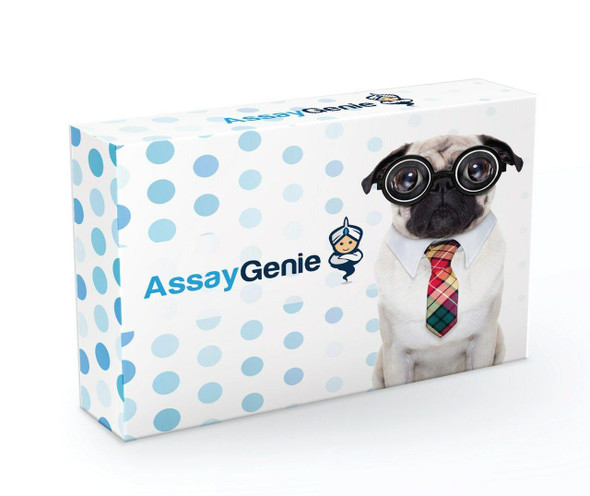XRCC6 Antibody (PACO03293)
- SKU:
- PACO03293
- Product type:
- Antibody
- Reactivity:
- Human
- Host Species:
- Rabbit
- Isotype:
- IgG
- Application:
- ELISA
- Application:
- WB
- Antibody type:
- Polyclonal
- Conjugation:
- Unconjugated
Description
| Antibody Name: | XRCC6 Antibody |
| Antibody SKU: | PACO03293 |
| Size: | 50ug |
| Host Species: | Rabbit |
| Tested Applications: | ELISA, WB |
| Recommended Dilutions: | WB:1:500-1:2000 |
| Species Reactivity: | Human |
| Immunogen: | synthesized peptide derived from human Ku-70 around the non-acetylation site of K542. |
| Form: | Liquid |
| Storage Buffer: | Liquid in PBS containing 50% glycerol, 0.5% BSA and 0.02% sodium azide. |
| Purification Method: | The antibody was affinity-purified from rabbit antiserum by affinity-chromatography using epitope-specific immunogen. |
| Clonality: | Polyclonal |
| Isotype: | IgG |
| Conjugate: | Non-conjugated |
| Synonyms: | XRCC6; G22P1; X-ray repair cross-complementing protein 6; 5'-deoxyribose-5-phosphate lyase Ku70; 5'-dRP lyase Ku70; 70 kDa subunit of Ku antigen; ATP-dependent DNA helicase 2 subunit 1; ATP-dependent DNA helicase II 70 kDa subunit; |
| UniProt Protein Function: | Ku70: a mini-chromosome maintenance protein, essential for the initiation of eukaryotic genome replication. Allows DNA to undergo a single round of replication per cell cycle. Required for the entry in S phase and for cell division. |
| UniProt Protein Details: | Protein type:Helicase; DNA repair, damage; EC 3.6.4.-; Nuclear receptor co-regulator; DNA-binding; RNA-binding; EC 4.2.99.- Chromosomal Location of Human Ortholog: 22q13.2 Cellular Component: cytosol; membrane; nuclear chromosome, telomeric region; nuclear telomere cap complex; nucleoplasm; nucleus; transcription factor complex Molecular Function:5'-deoxyribose-5-phosphate lyase activity; damaged DNA binding; double-stranded DNA binding; double-stranded telomeric DNA binding; protein binding; protein C-terminus binding Biological Process: DNA ligation; DNA recombination; double-strand break repair via nonhomologous end joining; negative regulation of transcription, DNA-dependent; positive regulation of interferon type I production; positive regulation of transcription from RNA polymerase II promoter; positive regulation of transcription, DNA-dependent; protein heterotetramerization; regulation of smooth muscle cell proliferation; telomere maintenance |
| NCBI Summary: | The p70/p80 autoantigen is a nuclear complex consisting of two subunits with molecular masses of approximately 70 and 80 kDa. The complex functions as a single-stranded DNA-dependent ATP-dependent helicase. The complex may be involved in the repair of nonhomologous DNA ends such as that required for double-strand break repair, transposition, and V(D)J recombination. High levels of autoantibodies to p70 and p80 have been found in some patients with systemic lupus erythematosus. [provided by RefSeq, Jul 2008] |
| UniProt Code: | P12956 |
| NCBI GenInfo Identifier: | 125729 |
| NCBI Gene ID: | 2547 |
| NCBI Accession: | P12956.2 |
| UniProt Secondary Accession: | P12956,Q6FG89, Q9UCQ2, Q9UCQ3, B1AHC8, |
| UniProt Related Accession: | P12956 |
| Molecular Weight: | 65,149 Da |
| NCBI Full Name: | X-ray repair cross-complementing protein 6 |
| NCBI Synonym Full Names: | X-ray repair cross complementing 6 |
| NCBI Official Symbol: | XRCC6 |
| NCBI Official Synonym Symbols: | ML8; KU70; TLAA; CTC75; CTCBF; G22P1 |
| NCBI Protein Information: | X-ray repair cross-complementing protein 6 |
| UniProt Protein Name: | X-ray repair cross-complementing protein 6 |
| UniProt Synonym Protein Names: | 5'-deoxyribose-5-phosphate lyase Ku70; 5'-dRP lyase Ku70; 70 kDa subunit of Ku antigen; ATP-dependent DNA helicase 2 subunit 1; ATP-dependent DNA helicase II 70 kDa subunit; CTC box-binding factor 75 kDa subunit; CTC75; CTCBF; DNA repair protein XRCC6; Lupus Ku autoantigen protein p70; Ku70; Thyroid-lupus autoantigen; TLAA; X-ray repair complementing defective repair in Chinese hamster cells 6 |
| Protein Family: | X-ray repair cross-complementing protein |
| UniProt Gene Name: | XRCC6 |
| UniProt Entry Name: | XRCC6_HUMAN |










